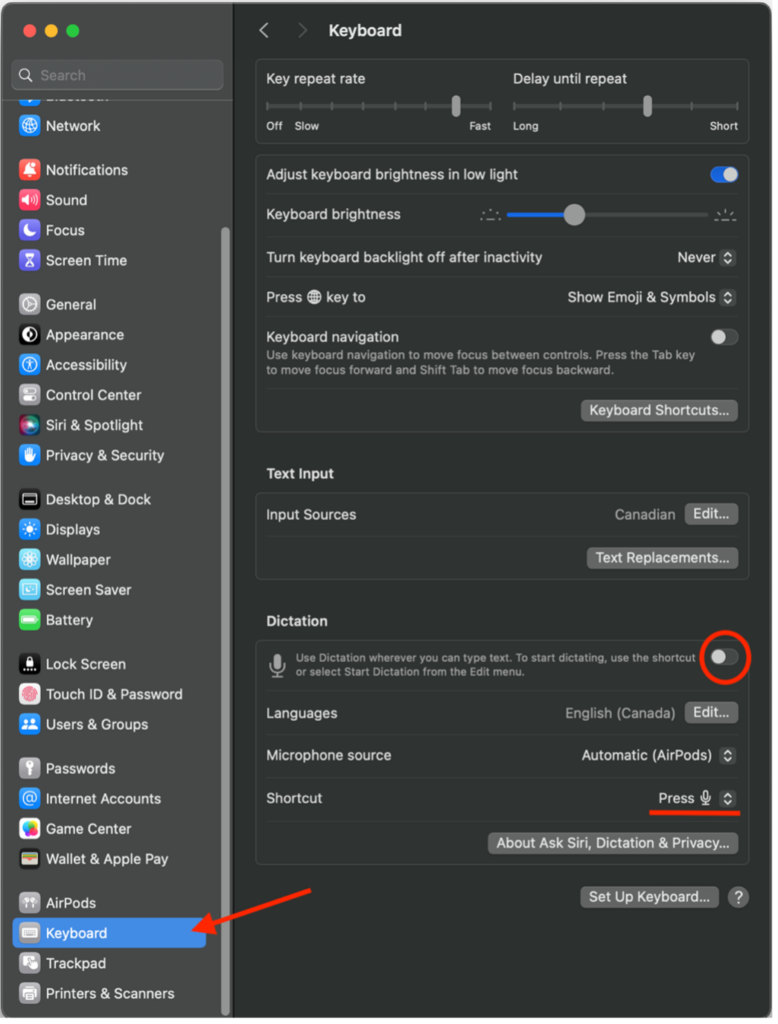Assistive Technology User Guides
Speech to text tools

On this page:
Windows Dictate
- Open Settings and navigate to Privacy. Select Speech and toggle Online speech recognition to On.
- Press Windows h to dictate text.

Use voice typing to talk instead of type on your PC
Word Dictate
To dictate speech-to-text, use any version (Windows, macOS, Web, mobile) of Microsoft Word:
- On the Home ribbon, click the microphone icon labelled Dictate.

- Wait for the Dictate toolbar and Listening message to appear.

- Speak slowly and clearly to dictate text.
- Speak punctuation such as “period,” “comma,” and “question mark.”
- Say “pause dictation” or “stop dictation” to stop dictation. Click the microphone to resume.
Dictate your documents in Word.
Settings

The gear icon on the toolbar opens Dictation Settings which includes options for:
- Spoken language.
- Set language for accurate spelling.
- Microphone.
- If multiple microphones are available, this menu indicates which will be used.
- Auto-punctuation.
- Toggle this setting on or off.
- Filter sensitive phrases.
- On by default, this setting ensures any errors in dictation don’t incorrectly attribute potentially offensive phrases to the speaker. Profanity or other sensitive language will be censored with asterisks.
Android
Users can dictate text in Android and ChromeOS. Many default apps (Chrome, Play Store, Docs) will include a microphone icon in the search box. Use that to search using your voice.

Tap the microphone to type using your voice.
Voice typing should be available by default, however if you do not see the microphone icon:
- Navigate to Settings > General Management.
- Select Keyboard list and default.

- Toggle on Google Voice Typing.

Use Live Transcribe to transcribe audio. To turn on Live Transcribe:
- Navigate to Settings > Accessibility.
- SelectInstalled apps.
- Choose Live Transcribe and toggleLive Transcribe shortcut to On.
- Tap on Accessibility shortcut.
- Select Live Transcribe.
- Follow prompts to set permissions.
- Activate Live Transcribe to transcribe audio to text.
Use Google Assistant to type with your voice.
iOS
- Navigate to Settings> General > Keyboard.
- Toggle Enable Dictation on.

- When the onscreen keyboard appears, tap the microphone icon in the bottom right.

macOS
macOS has a built-in dictation feature to use speech input to write documents. To enable:
- Navigate to System Settings.
- Select Keyboard.
- Select Dictation tab.
- Toggle button on.

To dictate text, select a text edit field (such as browser address bar or a document) and activate Dictation using the listed shortcut (microphone icon/F5 by default) or navigate to Edit > Start Dictation.
Speak slowly and articulate as best you can. Use natural language for commands, such as “new line” or “exclamation point”.
macOS has a complete list of dictation commands.
Learn more about how to dictate messages and documents on Mac.
Under System Preferences > Keyboard take note of language for spelling purposes. Verify correct microphone source. Choose between shortcuts or customize.
Dragon
Dragon can dictate into almost any text field. To do so:
- Ensure the blinking text cursor is in the area you want to dictate text.
- Activate Dragon.
- Begin speaking.
- Your text will be transcribed directly into the text field selected.
To turn Dragon on or off:
- When the speaker icon is red, Dragon is not listening. Click the icon to start Dragon.

- When the speaker icon is green, Dragon is listening and will transcribe what you say.

- Click the green icon to stop Dragon.
- When dictating, say “go to sleep” and the icon will turn blue. Dragon is in sleep mode and won’t transcribe what you say. Say “wake up” or click the icon to continue using Dragon to transcribe your speech.

If Dragon makes a spelling error, say “correct that.” If the correct word appears in the menu, select it to automatically replace the incorrect word with the correct one. If the correct word does not appear in the menu, say “spell that” and spell the word letter by letter.
Common Punctuation
- Say “period” or “comma” to add punctuation.
- Say “new line” to move to a new a line.
- Say “delete that” to delete your last transcribed text or “delete last (number) words” to delete the last number of words that were transcribed.
- If Dragon makes a spelling error, say “correct that.” If the correct word appears in the menu, select it to automatically replace the incorrect word with the correct one. If the correct word does not appear in the menu, say “spell that” and spell the word letter by letter.
- However, it may be most efficient to use Dragon to dictate most of your answer and then make minor corrections using mouse and keyboard.
Dragon Quick Start Guide (PDF).
Visit Dragon Watch and Learn for videos of common Dragon features in action.

